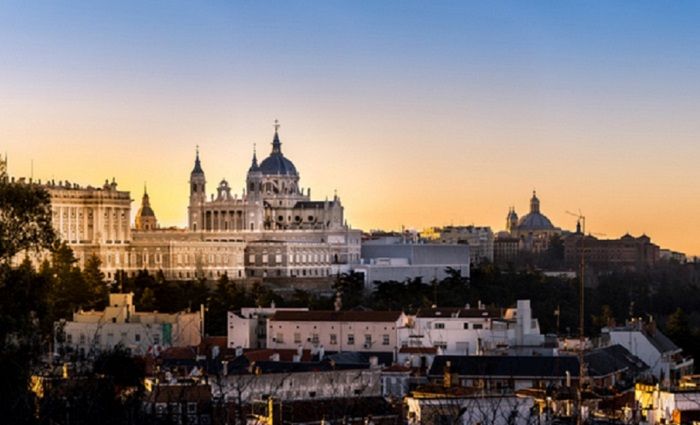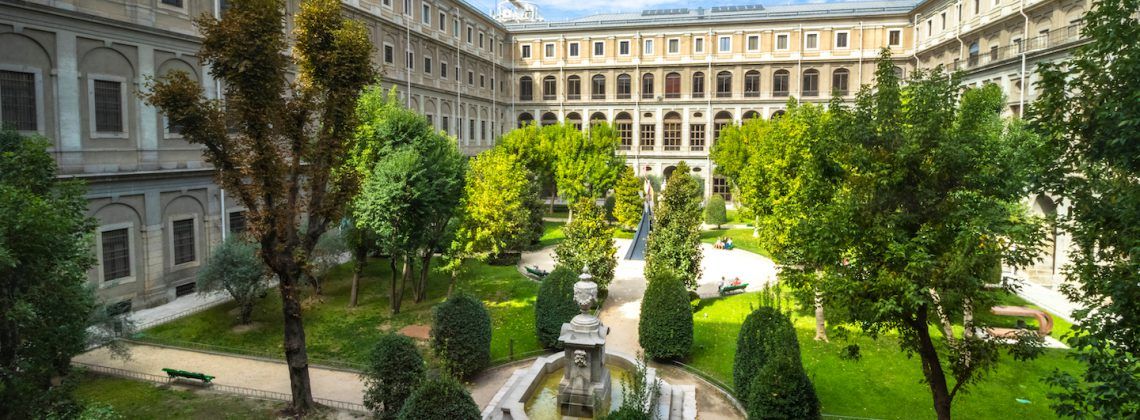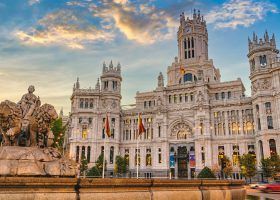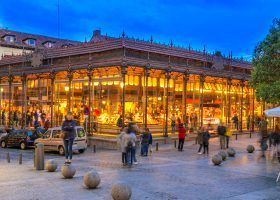The Reina Sofia is an incredible art museum to visit in Madrid with a contemporary focus. But what will you find here? Read on to discover the top things to see at Reina Sofia on your upcoming trip to Madrid.
The Museo Nacional Centro de Arte Reina Sofía, or the Reina Sofia, was once a hospital. The exterior might not seem impressive, especially when competing with the Prado, or even the Naval Museum. But the Reina Sofia houses an unparalleled collection of Spanish art and is one of the largest contemporary art galleries in the world. Here is where you will see Dali and Picasso. And while there is plenty to inspire and amaze, if you only went to stand in front of Guernica, that would be enough.
Let’s be honest, contemporary art can be challenging. We see it, we appreciate it, and sometimes we really get it. But other times, it can be overwhelming. We might stand there, wondering, is that her nose? Is that what I think it is? What am I supposed to feel? Or see? What is the artist trying to say?
This guide is designed to help demystify the surrealism of Dali and cubism of Picasso. It will help bring these masters into focus and make their works more interesting. Even if you feel like these grant artists need no explanation, read on! You pick up a new tidbit about these very talented, quirky, often sex-obsessed geniuses.
Figura en una finestra (Figure at the Window)
Salvadore I 1925 I Oil on papier-mâché I Room 205.06
We thought we’d start with a fairly straightforward Salvador Dali painting. Here, a young woman, his sister Ana Maria, looks out the window. The painting feels restrained, both with the color and with the approach. This is more realism than the surrealism that he’s known for. 1925, the year he painted this work, was also the year when he had his first solo-art exhibition.
He and his sister were very close, especially after their mother died. She was his favorite muse and he referred to her often in his 1942 biography, The Secret Life of Salvador Dali. However their relationship unraveled in a major way. She was frustrated by how he publicly vilified their father. He hated how she portrayed him in her biography of him. She was briefly arrested during the Spanish Civil War and believed that he had denounced her. But the real cause of their rift seems to be Gala.
Gala, born Elena Ivanovna Diakonova, was ten years older than Dali. Soon after they met, she left her husband, fellow surrealist Paul Éluard, and became Dali’s muse and business partner. Gala and Dali had a peculiar relationship, which we get into more, but suffice it to say, Gala and Ana Maria did not get along.
The rift became so toxic that Dali painted a second version of this painting, but in the wildly abstract style we better recognize. In that 1954 painting, a woman bends over, looking out the window, her naked behind surrounded by giant phalluses. It’s titled, Young Woman Auto–Sodomized by the Horns of her own Chastity.
Naturaleza muerta (Still Life)
Salvador Dali I 1924 I Oil on canvas I Room 205.17
We chose another of Dali’s works that is not easily recognizable in an effort to show his evolution. Here, he is clearly experimenting with different techniques, particularly metaphysics and cubism. Cubism was a revolutionary new style in European art. Pablo Picasso, also from Spain, helped to make the style wildly popular and more mainstream.
Dali is such a fascinating character, not just for his art, but for his ability to self-brand. While this painting is not an example of his later style, it is an example of his ability to adapt to trends. As he searched for his own artistic self, he began to perfect the image of Salvador Dali.
Dali was never in doubt of his own genius. In fact, according to his own 1942 autobiography, he was expelled from the School of Fine Arts in Madrid due to his own hubris. Despite being prepared for the topic of his oral thesis, he announced to the examining committee, “I am very sorry, but I am infinitely more intelligent than these three professors, and I therefore refuse to be examined by them.”
Dali scholar, O.B. Duane, writes, “Dali stood firm in his beliefs; he took a perverse pleasure in the scandals caused by his provocative and free-thinking spirit, he had developed confidence in his role as agitator and totalitarian, characteristics which were to flourish as his career developed further.”
Planning a trip to Madrid? Discover epic day trips from Madrid, our favorite hotels, and how to visit the Reina Sofia Museum!
Visage du Grand Masturbateur (Face of the Great Masturbator)
Salvador Dali I 1929 I Oil on canvas I Room 205.13
This is a more “Dali” Dali. The woman depicted in the painting is Gala. If you tilt your head to the left, you can see the profile of Dali himself, the tip of his nose touching the ground. Sexual tension, repression, and even depravity are on full display.
Dali painted this painting soon after Gala entered his life. She left her husband and joined Dali, recognizing him as a genius. According to Duane, Gala “became both his inspiration and his source of control. Without Gala, Dali’s genius may well have been powerless to express itself through his art; her patience and determination defeated the madness which threatened to overrun him.” It is no coincidence, therefore, that with Gala’s influence, he was able to find his defining style.
Retrato de Luis Buñuel (Portrait of Luis Buñuel)
Salvador Dali I 1924 I Oil on canvas I Room 205.17
Luis Buñuel and Salvador Dali first met as young artists at the Academy of Fine Arts in Madrid. Again, Dali scholar O. B. Duane gives insight, “the months during which these young intellectuals shared their literary and artistic ideas marked one of the most vital stages in the evolution of Dali’s personality and his subsequent art.” Buñuel and Dali were close and protective of one another, forming a deep friendship.
This portrait, completed in 1924, reflects Dali’s dabbling in realism, like the Figure at the Window. It has a similar monochromatic, straightforward approach. Dali puts Buñuel in the extreme forefront, his strong shoulders in striking contrast to the small buildings in the background.
As Dali’s fame grew, Buñuel found his own artistic outlet in film. In the late 1920’s the two worked on a film, The Andalusian Dog. According to Duane, “they had agreed one simple rule … neither would tolerate the use of any image or idea that could be considered rational, or governed by psychological or cultural norms. They hoped to achieve a result which would be unprecedented in the history of cinema and were therefore intent on probing the irrational and bombarding the audience with a series of images offering only the ludicrous coherence of a dream.”
Buñuel himself explained, “we wrote with minds open to the first ideas that came into them and at the same time systematically rejecting everything that arose from our culture and education.” The film took 15 days to produce and consists of a series of images that make the audience feel deeply disgusted. The recurring themes of death, decay, and sexuality directly reference Dali’s paintings.
L’âge d’or (Golden Age)
Luis Buñuel & Salvador Dali I 1930 I 35 mm film transferred to video I Room 205.15
The second film collaboration between Luis Buñuel and Salvador Dali did not go as well as before. Their first film, The Andalusian Dog, was an exercise in the grotesque and an equal cooperation between the two. Their second project, Golden Age, was produced by Charles and Marie-Laure Noailles and directed and edited by Buñuel.
While Dali and Buñuel worked together on the script, the two had serious disagreements. Buñuel completed the film on his own, which Dali saw as a betrayal. According to Duane, Dali felt that Buñuel “compromised all of his ideas, to produce a work whose originality was suffocated by a pathetic anticlericalism.” Despite their rift, when the film debuted in November 1930, it only added to Dali’s fame.
The 63 minute film, “a catalog of the symbols and attitudes of Surrealism,” according to film archivist Mary Corliss, “represents, perhaps, the very pinnacle of achievement in Surrealistic cinema.” However, in 1930, the film was seen as an attack on the Catholic church. It inspired such strong feelings that a group of protesters splashed the screen with ink and set off stink bombs. Today though, Corliss argues, “modern audiences will take the ferocity of Buñuel’s attack as anarchic high spirits,” and watch with “delighted laughter.”
Verres, journal et bouteille de vin (Cups, Newspaper and Bottle of Wine)
Juan Gris I 1913 I Collage, colored pencil, gouache and black chalk on paper glued to paperboard I Room 207.02
Juan Gris, born José Victoriano González-Pérez, was born in Madrid in 1887. A contemporary of Pablo Picasso, he spent most of his painting career in Paris. He died young, at 40 years old, of kidney failure.
Art historian, Douglas Cooper, describes Gris as “highly respected and praised,” but that he “has never been properly recognized as the great creative artist he undoubtedly was.”
In comparison with the other artists showcased in this guide, Gris is much more subtle. He is subtle in both style and temperament. As Cooper explains, Gris’ “paintings are austere… he put little emphasis on sensuous and emotional values.” He continues, they “oblige the spectator to think before he begins to enjoy them.”
However, he adds that the paintings’ organization and logic result in “great visual satisfaction, just as his eminently personal sense of color is evocative, fresh, and exciting.”
La bouteille d’anis (The Bottle of Anis)
Juan Gris I 1914 I Oil, collage and graphite on canvas I Room 206.03
When Gris moved to Paris in 1906, he found a small studio next to Picasso. Over the next few years, he bore witness to the new, fantastically revolutionary style, cubism.
This painting, while an excellent example of Gris’ style, has layers of hidden meaning. It is, in essence, a love note to his fellow cubist, Picasso and Georges Braque. Buried within the detail, we see the words Paris, Badalona, and Madrid. Each of these is a city linked to one of the three artist: Picasso, Braque, and himself. It also says “Premio,” reminding the viewer of their excellence.
Douglas Cooper explains the difference between the three lions of cubism, at least during this period. Gris’ cubist paintings, he argues, are ” bolder, less dependent on the nuances of fine painting, more assertive and visible legible.”
La table du musicien (The Musician’s Table)
Juan Gris I 1926 I Oil on canvas I Room 206.03
Juan Gris often painted musical instruments. The Musician’s Table is a far departure from Gris’ early works. Completed the year before he died, this painting is many losers, less linear. Here we can compare this period of his artistic expression with his works from twenty years before.
Many critics, especially American academics, consider his later years to be his weakest. But Douglass Cooper argues the opposite. Certainly, he says, there were some periods of transition in the mid-1920s. But then, Gris “found a new artistic strength and pictorial equilibrium.” Cooper suggests that the “formal ‘rhymes’ and linear rhythms lose nothing of their lyrical inspiration.”
Coming to Spain? Learn how much the Vikings influenced the history of Spain, things in Spain you must see, and what to explore at the Alhambra.
Instruments de musique sur une table (Musical Instruments on a Table)
Pablo Ruiz Picasso I 1924 I Oil on canvas I Room 206.03
If we stay in the same room as Gris’ The Musician’s Table, we find Picasso’s similarly themed painting. Pablo Ruiz Picasso was born in Malaga, Spain in 1881. Picasso was a known talent from an early age. He was never a particularly humble man. In fact, he once announced, “when I was a child, my mother said to me, ‘if you become a soldier you’ll be a general. If you become a monk you’ll end up as the Pope. Instead, I became a painter and wound up as Picasso.'”
Here we have an example of a still life, a tradition passed down from the great Dutch masters. Picasso painted various takes on the same theme, but this one is unique. Here he is keeping the forms defined. The color palette is simple. The lines are clean. We know that these are instruments because he told us. However, there is plenty of room for interpretation.
Picasso famously proclaimed that no painting was every finished. Finishing a painting would kill it and rid it of its soul. While The Musician’s Table seems to be a complete and coherent work of art, it’s hard not to wonder, what would Picasso have added or edited?
La femme au jardin (Woman in the Garden)
Pablo Ruiz Picasso I 1930-1932 I Welded bronze I Room 205.13
Perhaps one of the best-known details of Picasso’s life is that he had many muses. Women played an important role in his life. In fact, some scholars even think of his various artistic periods linked to the woman in his life. Thus it is not surprising that his sculpture is of a woman’s form, although certainly abstract. You’ll notice that he’s added elements of the natural world that contrast with the stark human figure.
Picasso was often reinventing himself. He was an artist because he had to be an artist. This sculpture is an example of his ability to experiment. He worked closely with fellow Spaniard and sculptor, Julio González. As he learned to weld, his sculptures became more abstract and complex.
Picasso scholar, Ingrid Schaffner, describes his process in her book, The Essential Pablo Picasso. He was, she says, “always questioning, what can this picture be.” But perhaps more to the point, “what can be a picture.” That’s where his sculpture came in. He worked hard, Schaffner continues, “to express his enormous talents and rigorous visual thinking about essential questions of representation, a process that led him to constantly reinvent his own art.”
Picasso puts it this way, “what is sculpture? What is painting? Everyone clings to old-fashioned ideas and outworn definitions as if it were not precisely the role of the artist to provide new ones.”
Minotaure caressant une Dormeuse (Minotaur Caressing a Sleeping Woman)
Pablo Ruiz Picasso I 1933 I Drypoint on laid paper I 205.11
It is difficult to think of Picasso and not consider his many muses. Married, 45-year old, father of one, met seventeen-year-old Marie-Thérèse Walter in Paris one cold winter morning. Walter, young and blond, instantly became his newest muse. The two had a wild affair for the next 13 years.
The minotaur was a Picasso’s favorite symbol for himself. We again turn to Ingrid Schaffner, who explains, “the 1/2 man, 1/2 bull is a recurrent image in Picasso’s work that he begins to explore in 1928.” This is right around the time he met Marie-Thérèse.
He worked on a series of minotaur drawings throughout his time with Marie-Thérèse Walter. It seems that he was the minotaur, big and brutish, compared to the teenage Walter. Marie-Thérèse is the sleeping woman. The works are overtly explicit. They suggest dominance and brutality. The minotaur shows animal or unconscious impulse and a desire to destroy. The woman represents innocence and purity.
Guernica
Pablo Ruiz Picasso I 1937 I Oil on canvas I Room 205.10
Guernica is one of the most famous paintings in the world. Its size is overwhelming. Its subject matter is awful. We stand in front of this masterpiece and we are stunned. School children gather around it a become silent. Its power is in its directness. There is no hiding from the message of the horror of war.
Guernica depicts the real-life events of the bombing of a Basque village during the Spanish Civil War. German Nazis and Italian Fascists aided Republican factions, led by General Franco, led an air raid against Guernica on a quiet afternoon in 1937. The number of people dead is in dispute, some arguing it was over 1000.
Guernica appears simple. The colors are muted, a landscape of matte black and gray. What we see is on top of eight earlier versions. The bottom layers help to create its richness, despite the monochromatism. He painted the canvas white and added crushed glass, which lets light come in and bounce out.
The story of the bombing is told both through symbols and characters. The horse, for example, lies dying from a lance, as if in a bullfight. The bull, perhaps the most enigmatic character, stares passively.
Perhaps the most poignant portraits are the women, weeping, crying out in pain. Here is Picasso at his most powerful as he plays to our deepest sympathies.
Guernica’s Legacy
The work is seven meters long and was finished in 7 weeks. It was an immediate sensation and made people see the war and the related atrocities.
The horror of the event shook the world. As news spread, Guernica became a symbol of the totality of war. Women and children, unarmed civilians were targeted, bombs lit the town on fire, and enemy planes strafed as people ran for cover. Franco and his forces may have won the war, but the legacy of their crime lives on in Picasso’s work.
Picasso instructed that he did not want the painting to be in Spain as long as Franco was in power. Thus, after Franco’s death, the painting left New York and found its new home at the Reina Sofia.
Picasso was proud of Guernica, what is arguably the most important, or symbolic work of the twentieth century. He wrote, “it is my wish at this time to remind you that I have always believed, and still believe, that artist who live and world with spiritual values cannot and should not remain indifferent to a human conflict in which the highest values of humanity and civilization are at stake.”

Where to Stay in Madrid
Madrid is a vast city with many areas to stay in, including beyond the downtown area. Choose a hotel near the top things you want to see in this beautiful old city.






Excelente haber haber obtenido en su documentation informaciones importante de unos de mis Artistas preferido como Pablo Ruiz Picasso . Mi mayor impression ,fue su valor espiritual , y el corage para decirle no a la indiferencia de los conflictos humanos.
Hermosa vistas panoramica de Madrid .